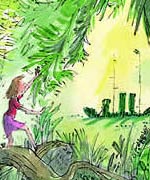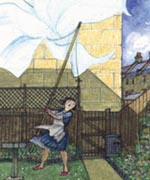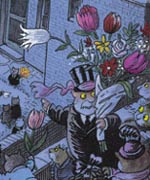>> Editorial: Camera Obscura - The Call
>> Editorial: Camera Obscura - Whisky Business
More...

THROUGH THE DOOR
2003. Happy New Year, folks. Hope the holiday season was everything you wanted it to be. Made any resolutions? Given any thought to what you'd like to see this year, or what you'd like to get done? Any idea what the next year is going to bring for comics?
Doom and gloom, of course. More films, more mainstream exposure of a medium with its trousers down, as superheroes continue to hit the big screen and reinforce the public's perception of comics as a medium for children.
You'll have to forgive me. The festive season is over, and I have a backlog of being a grumpy so-and-so to catch up on. Actually, I've got no bloody idea where 2003 is going, but there's a tradition of claiming each new year in comics as something terrible. So I hereby proclaim that 2003 will be the Year Of The Ingrowing Toenail - septic and painful, but unlikely to be actually fatal. I figure I've got as much chance as anyone else of being right.
THE DOORS OF PERCEPTION
Of course, with it being the festive season, I've had time off - actually, I'm changing jobs, and haven't started the new one yet, so I took advantage of the break and spent the other day kicking around a few improving exhibitions.
Metamorphing at the Science Museum was, if you like, a purely personal indulgence, taking a poke around a mix of esoteric science and mad dead culture. Or live culture in some cases. An exhibition focused on change.
Rewind at the Victoria and Albert Museum is the Design & Art Direction awards retrospective - a display of the best of the last 40 years in design and advertising. The beat of mainstream communication. It occurs to me that it might be interesting to compare and contrast the images and techniques in use there with the same period in comics, and find out just how in or out of step the medium has been, whether it's been behind or ahead of the curve with any kind of consistency.
 But before those two, and by far the most interesting of the three, I went along to the Magic Pencil exhibition at the British Library.
But before those two, and by far the most interesting of the three, I went along to the Magic Pencil exhibition at the British Library.
Quentin Blake, probably best known for his work illustrating the books of Roald Dahl, has put together a showcase of some of the best work in the field of children's illustration.
Illustrated prose is only half a step away from comics at the best of times - indeed, as an interview recorded with Blake as part of the exhibit makes clear, it was important to Dahl that the pictures be an equal partner to the words, and take on their share of the storytelling work. Blake would get the manuscripts from Dahl with the places that an illustration should be inserted marked, so as to free Dahl from getting bogged down describing in prose what the art would show...
Yes, the line is very blurred indeed to the point where a few comic creators were included as part of the exhibit. Naturally, they're the ones that no-one talks about, the ones who can actually sell to a mainstream audience here in Britain, such as Posy Simmons and Raymond Briggs. But more about them in a minute.
 What struck me about the show is that for all the criticism levelled at comics in general and superheroes in particular as being for children, actually, kids books are often (not always, but often) more challenging and experimental in their approach to their subject than most mainstream comics. There's more variety of techniques and media in illustrated books for kids than you're likely to find in any random sampling of thirty Anglophone comics.
What struck me about the show is that for all the criticism levelled at comics in general and superheroes in particular as being for children, actually, kids books are often (not always, but often) more challenging and experimental in their approach to their subject than most mainstream comics. There's more variety of techniques and media in illustrated books for kids than you're likely to find in any random sampling of thirty Anglophone comics.
Even the "conventional" comics work in the exhibition stands apart from the norm in the medium. Briggs' pages and panels may obey a pretty strict rule of thirds (a photographic or design principle based on where the focus of attention naturally falls - along the lines that you might draw to divide a picture into thirds), but they pack a truly staggering density of words and information into what mainstream comics would consider very, very small panels, and still keep a strong emotional current moving, without ever seeming dry or over-wordy. WHEN THE WIND BLOWS is still one of the most powerful comics I've ever read.
 Posy Simmonds, of course, wins really serious acclaim for her work; she was awarded an MBE in 2002 for "services to the newspaper industry", which might suggest that her very unconventional looking comics and cartoon illustrations are enjoying an awful lot more acclaim outside comics than within, unless I'm missing all the conversation about GEMMA BOVERY, or her editorial work...
Posy Simmonds, of course, wins really serious acclaim for her work; she was awarded an MBE in 2002 for "services to the newspaper industry", which might suggest that her very unconventional looking comics and cartoon illustrations are enjoying an awful lot more acclaim outside comics than within, unless I'm missing all the conversation about GEMMA BOVERY, or her editorial work...
Then there's Lauren Child, with her weird and wonderful mix of text and different kinds of image in her collaged Clarice Bean series, using some of the most interesting layouts I've seen in a while, or Sara Finelli, creating even stranger collages, which seem to delight the children that buy her books in hordes, and when she's not doing that, winning awards for designing postage stamps. Or Angela Barret's works, which move from children's fiction, to adaptations of classics like the story of Joan of Arc, or Voltaire's CANDIDE.
There's a whole field, just a step away from comics, that we ignore, despite the fact that it's more successful on just about ever level, and has an awful lot to teach us. It's our loss. Still, you could do worse that take a look at the Magic Pencil website or, if you're in London with an afternoon to spare in the next couple of months, pop along. It's free, apart from the temptation to spend a small fortune in the giftshop.
RIDING ALONG
In closing, I just want to touch on something my colleague Andrew Wheeler has already mentioned - THE RIDE TOGETHER, a book, half comics and half prose, about life with an autistic brother, by Judy and Paul Karasik. Andrew passed me the proof he was sent, and I was duly touched and impressed by it. It's due out very soon, and it's a wonderful piece of work. Keep an eye out for it.

This article is Ideological Freeware. The author grants permission for its reproduction and redistribution by private individuals on condition that the author and source of the article are clearly shown, no charge is made, and the whole article is reproduced intact, including this notice.


